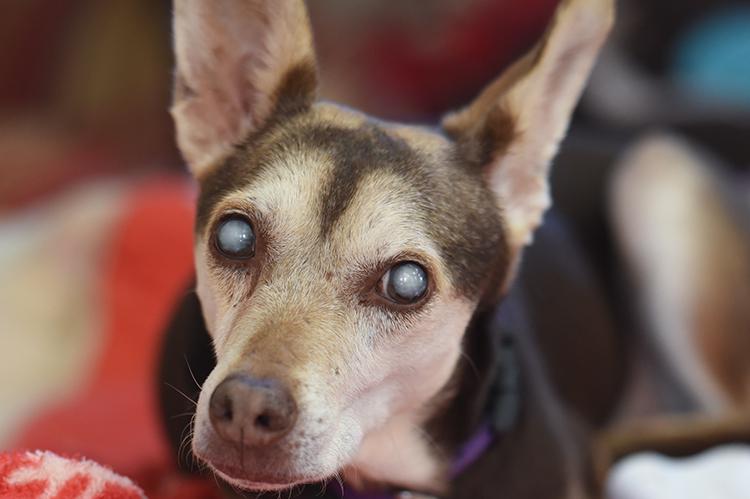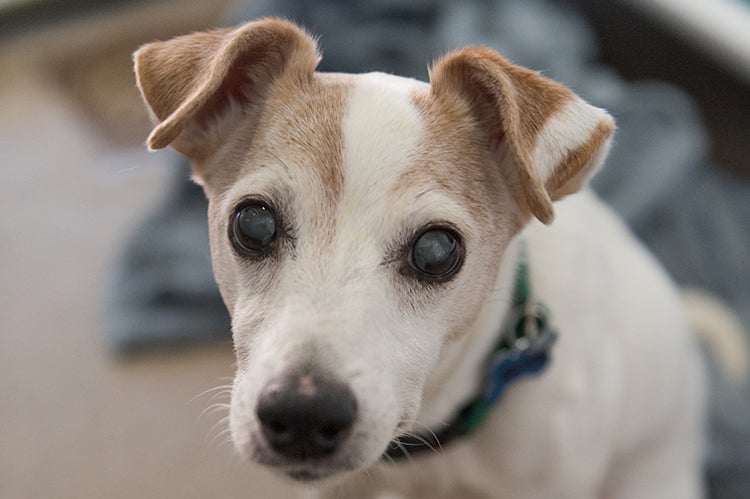Cataracts in Dogs: Signs, Causes, Diagnosis, and Treatment

Cataracts in dogs occur when the lens of the eye clouds due to either changes in the water balance in the lens or changes to the proteins within the lens. This causes blindness because light can’t reach the retina through the cloudy lens. A mature cataract looks like a white disk behind a dog’s iris. The part of the eye that usually looks black instead looks white.
People often think their pets have cataracts when they really have nuclear sclerosis. Nuclear sclerosis is haziness caused by hardening of the lens as a dog gets older. All animals experience this change with age. The good news is that light is still able to pass through to the retina, so your dog can still see with nuclear sclerosis — perhaps just not as well as when your dog was younger.
So what do you do if you think your dog has cataracts? Here's what to know about the causes, diagnosis, and treatment of cataracts in dogs.
Diagnosing canine cataracts
If you’re worried that your dog might have cataracts, make an appointment with your veterinarian. By using a bright light and a magnifying lens, a vet can detect cataracts that are just forming or are immature and haven’t yet started affecting your dog’s sight.
Your vet will also be able to screen for other eye problems, such as anterior uveitis (inflammation) and glaucoma (increased pressure), that can occur with cataracts. Plus, through blood work and blood pressure checks, the vet will look for systemic diseases that can affect sight, such as diabetes and hypertension. Taken all together, the exam findings, clinical signs, and test results will give an overall view of your dog’s health and vision.
Cataracts can develop very slowly or almost overnight. You probably won’t notice any change in your dog during the early stages, but once the cataracts are mature (completely blocking light transmission to the retina), the dog will be blind.
Signs that the cataracts have progressed include a dog bumping into walls or furniture, being unsure about stairs, and having trouble finding food and water bowls. Dogs are very adaptable, however, and soon learn to function without sight. In fact, if the cataracts come on slowly, you might not even notice that your dog has gone blind.
Causes of cataracts in dogs
Cataracts are frequently hereditary. Scientists have identified gene mutations in several dog breeds that increase the risk of cataracts. In fact, more than 100 dog breeds are known to have some incidence of hereditary cataracts. Genetic testing is available, but please note that not every dog with the mutation will develop cataracts, just as some without the mutation will.
The other common cause of cataracts is diabetes. Almost all diabetic dogs develop cataracts within a year of diagnosis. High blood sugar levels change the balance of water in the lens, and consequently cataracts form. Often diabetic cataracts appear very rapidly, with a dog losing sight within a day or two of having any trouble at all. Delaying or preventing diabetic cataracts has been a topic of great veterinary research. For example, oral antioxidants might delay formation, so talk with your veterinarian about options.

Dog cataract treatments
Luckily, there is highly effective surgical treatment for cataracts in dogs. As with people, other animals — including dogs, cats, horses, and even goldfish — can have cataract surgery to remove the cloudy lens and restore sight.
A veterinary ophthalmologist can determine whether your dog is a good candidate. Surgery is not a good option for all dogs. Occasionally, a dog will have inflammation in the eyes, glaucoma, or damaged retinas, making it unlikely that surgery will be successful.
In addition, sometimes a dog will have another illness (e.g., kidney or heart disease) that is bad enough to make anesthesia too risky. If this is the case, anti-inflammatory eye drops might be prescribed long term to help control inflammation. Although these drops won’t treat the cataracts directly or restore sight, they can delay or prevent lens-induced glaucoma.
Lens-induced glaucoma occurs when proteins from the cataract are released into the eye, causing an inflammatory reaction that clogs the outflow of fluid. Excess fluid then builds up within the eye increasing the pressure, which is very painful. Other eye drops can be used to help manage glaucoma, but this disease is difficult to control over time.
To sum up: Make an appointment with your veterinarian if you’re concerned about cataracts in your dog. If your dog does have them, discuss the options with your vet. If surgery is an option, having it sooner minimizes the difficulty and risks. Even if surgery isn’t an option, getting your dog on the right medications will help minimize associated complications. And don’t despair if your pooch can’t be helped with surgery. Such dogs might need a little more guidance, but they can still live a rich, wonderful life.